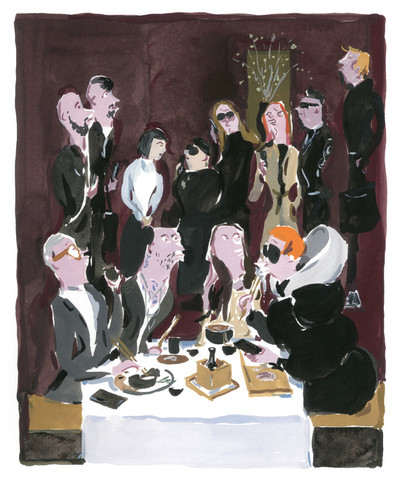How the digital world has transformed fashion’s love of gossip.
By Guy Trebay
Illustration by Jean-Philippe Delhomme
How the digital world has transformed fashion’s love of gossip.

The gossip of the day travels along the front rows, around tables at Da Giacomo in Milan, Kinugawa in Paris, and The Grill in New York, or else through the digital ether, wafting like a tainted zephyr. Have you heard that X, a world-famous designer is riddled with cancer and is now on his last legs? Did you know that Y, barely back from rehab, has suffered a relapse? Of course, you know, don’t you, that M is rumoured to be out as creative head of that big multinational, soon to be replaced by H? They say H has already relocated to Paris and is building a stealth team. What do you think about that diva designer tapped to head a global label? Did you hear he insisted on bringing his own team and held out for a contract paying $18 million a year? And how about that infamously dissolute model? Was she really so wasted at a garden party that she face-planted into a shrub?
It is empty and yet somehow important, this idle chatter that is a low-register soundtrack scoring the migrations of the fashion caravan, helping editors and photographers and critics and reporters and models and agents and all the assorted personnel while away the hours. And there is a surprising number of these. For all that the fashion cycles appear – and in many ways are – antic and exciting, they are also filled with longueurs, tedious periods of waiting that are filled with a hard to control anxiety induced by so much enforced passivity.
Are those in the fashion business more prone to indulge in gossip than office workers or supermarket cashiers, I wonder? Probably not. Yet spend enough time in front rows, backstage or at lavish (if seldom very jolly) dinners underwritten by corporate budgets and you cannot escape the impression that gossip is both catnip to the occupationally fabulous and also a critical professional tool.
The reasons are simple. No matter how dense our digital connections, news still travels first and fastest by word of mouth. Scurrilous or malicious or often downright misguided, the gossip that threads through the months-long fashion show cycles serves as an odd form of community building. Drawn together twice yearly from scattered professional pursuits, the fashion pack reconstitutes itself ad hoc. Teams and individuals land in the fashion capitals of New York, London, Milan and Paris and power nexuses are quickly recalibrated. New players are incorporated into the group. New alphas are identified. Beloved characters made suddenly redundant are quietly cast onto the ice.
For a business as reliant as fashion on a roving population of freelance workers, this means of spreading information is strangely important. For all the minor players in what remains – despite its increasingly corporate centralization and vast global reach – a largely tribal business, tracking and diagramming personnel shifts and subtle changes of power are a necessary practice. Gossip is, of course, in all settings a form of currency; no matter how remote you are from the sources and principals of a given tale, having some to retail is a sign of belonging. And since the pursuit of the fashionable is an inherently conformist undertaking, gossip also tends to function as a mechanism of social and even moral regulation. Well before the establishment of the #MeToo movement, an awful lot of what you heard on the fashion circuit involved tales of sexual misdeeds or borderline criminal transgressions – light-fingered stylists, models pressured into compromising situations, social-media influencers greedy about ‘samples’, designers caught in South American love nests with underage boys.
It strikes me that this form of improvised governance is not necessarily a bad thing in a business that only lately instituted even rudimentary rules for the workplace. Long before public revelations emerged about photographers with unsavoury and predatory sexual habits, warnings were transmitted by jungle telegraph, tipping people off about who to watch out for and which dude was the one who would try to get into your pants.
There is something else. The entertainment value of gossip is, of course, largely predicated on the levelling sense it provides us of superiority over others, particularly those famous others so remote from our ordinary lives. Social media complicated all this somewhat when everyone in fashion (and also outside it) began to burnish their public personas with curated Instagram images of lives characterized by their dully perfected surfaces. Deep down we all know that, beyond the frame of those digital postcards, there must lie the usual mess of daily existence. Luckily, we can rely for reassuring confirmation of these suspicions on the good old rumour mill.